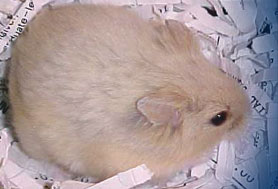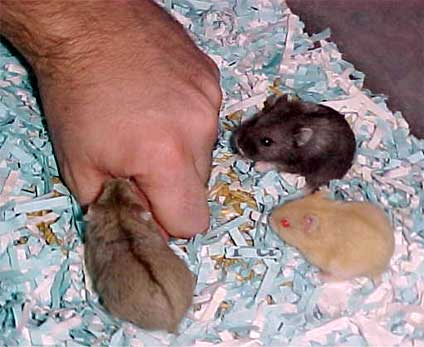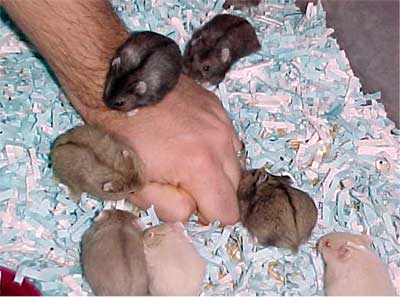Baby hamsters are born
naturally curious and they are not really sure what to
make of a human being. They often will roll over on their
backs and squeak if confronted with a hand when very young
or push your hand with their paws and run away. They need
to learn that humans will not hurt them and in turn that
it is ok for them to be nice and friendly and NOT bite!
You can start socializing baby hamsters at 10 days of age if the
mother will allow it. If she will not allow you near them.
Do not worry. They can still be socialized right when they
wean at 18 days to 21 days. (Anytime up until 4 weeks is
the most ideal time frame as they are much more likely
to bite you hard when taming them at an older age).
I usually socialize my
babies by putting them in a big tub if they are not already
in one and I
place my hand in a loosely balled fist, palm down. The
babies almost immediately run up and start to nibble on
my hand or punch it with their paws.Some will bite, but
most go from nibbling to trying to climb up my hand and
then arm. Once they get past nibbling and start climbing
I gently pet each hamster while they are in my hand. Before
I stop socializing them I pick up each baby and gently
pet it while it is cupped in BOTH of my hands. Making a
little cave with your hands will make them feel more secure.
It is important to hold the babies over something low and
soft (I use the bin with shredded paper) because if they
are at all frightened they will think nothing of jumping
out of your hand, quicker than you can catch them.
It really
is best to start with a loosely balled hand when you
start socializing babies for a reason. Most dwarf hamsters
have
a preference for biting finger tips
and especially
finger
nails so if
these
are
protected,
you will suffer less injury in the process! Once they
get used to you you can offer the back of your hand and
palm
up. Just watch and gently push a baby away if it starts
to really bite hard.
There may be a few babies
that are born aggressive. Most of these you can tame
with patience
but some are born mean and will stay that way. These
are usually the hamsters that grow up to attack people
or who
are violently aggressive towards other hamsters. For
this reason, it is better to house such a hamster alone
if he
starts to bother his cagemates. If you handle the babies
once or twice a day and put your hand in the cage for
maybe 15 minutes each evening starting at 3 weeks of
age, almost
all the babies will be tame by the time you find them
homes at 4 weeks of age (or older). For the most part,
this type of socializing
results in adult hamsters that stay sweet even if not
handled for a few days.





